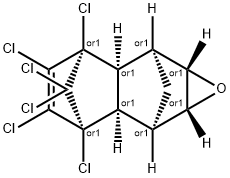엔드린 C화학적 특성, 용도, 생산
화학적 성질
Endrin is an organochlorine compound. Endrin appears as a white or beige crystalline solid and is stable. It is incompatible with strong acids and strong oxidisers and corrodes some metals. Endrin decomposes on heating above 245°C, producing hydrogen chloride and phosgene. Endrin is incompatible with strong oxidisers, strong acids, and parathion and emits hydrogen chloride and phosgene when heated or burned.
물리적 성질
White, crystalline solid when pure; light tan color with faint chemical odor for technical grades.
Odor threshold concentrations in air ranged from 18 to 41 ppb (quoted, Keith and Walters, 1992).
Robeck et al. (1965) reported an odor threshold concentration of 9 ppb.
용도
All uses of endrin in the United States
were canceled by the manufacturer in 1986;
formerly used as an insecticide, avicide, and
rodenticide
정의
A stereoisomer of dieldrin which is the endo, exo
isomer.
일반 설명
ENDRIN is a white crystalline, odorless solid dissolved in a liquid carrier. ENDRIN is water emulsifiable. ENDRIN is toxic by inhalation, skin absorption, and/or ingestion. When heated or burned ENDRIN may emit toxic hydrogen chloride and phosgene. ENDRIN is used as a pesticide.
반응 프로필
While a mixture of parathion and ENDRIN was being blended into a petroleum solvent, an exothermic reaction occurred that caused some of the petroleum solvent to vaporize. The solvent-vapor-air mixture exploded. The mechanical agitation possibly initiated the exothermic reaction, Doyle(1973). Toxic hydrogen chloride and phosgene may be generated when solution burns. Avoid strong oxidizers, strong acids and parathion. [EPA, 1998].
위험도
Toxic by inhalation and skin absorption,
use may be restricted. Headache, liver damage, and
central nervous system impairment. Questionable
carcinogen.
건강위험
ENDRIN is extremely toxic. It is rapidly absorbed through the skin. Symptoms appear between 20 minutes and 12 hours after exposure. There is evidence that ENDRIN may cause chromosomal damage. Doses of 1 mg/kg can cause symptoms. It is a suspected carcinogen. Also, it is a central nervous system depressant and hepatotoxin. Pregnant women are considered to be at special risk.
화재위험
Toxic hydrogen chloride and phosgene may be generated when solution burns. Avoid strong oxidizers, strong acids and parathion.
농업용
Insecticide, Avicide: Not approved for use in EU countries. A U.S.
EPA restricted Use Pesticide (RUP). It is a persistent and
acutely toxic insecticide. Endrin is an insecticide which
has been used to control insects, rodents, and birds, mainly
on field crops such as cotton, maize, sugarcane, rice, cereals,
ornamentals, and other crops. It has also been used
for grasshoppers in non-cropland and to control voles and
mice in orchards. Once widely used in the U.S., most uses
were canceled in 1980 and it has not been produced nor
sold in the U.S. since 1986. It is not easily dissolved in
water and can remain in the soil for more than 14 years.
상품명
COMPOUND 269®; EN 57®;
ENDREX®; ENDRICOL®; ENDRIN CHLORINATED
HYDROCARBON INSECTICIDE®; HEXADRIN®;
MENDRIN®; NENDRIN®; OKTANEX®
Safety Profile
Poison by ingestion,
skin contact, and intravenous routes.
Experimental teratogenic and reproductive
effects. Questionable carcinogen. Mutation
data reported. A central nervous system
stimulant. Highly toxic to birds, fish, and
humans. Many cases of fatal poisoning have
been attributed to it. Does not accumulate
in human tissue. In humans, ingestion of 1
mg/kg has caused symptoms. A dangerous
fire hazard. Mixtures with parahon dlssolve
very exothermically in petroleum solvents
and may cause an air-vapor explosion. See
also ALDFUN.
잠재적 노출
A potential danger to those involved in
manufacture, formulation and field application of this insecticide, avicide, and rodenticide. Pesticide not in use; TRI and/
or IUR indicates importers or manufacturers are unlikely.
운송 방법
UN2761 Organochlorine pesticides, solid, toxic,
Hazard Class: 6.1; Labels: 6.1-Poisonous materials
비 호환성
Incompatible with strong oxidizers
(chlorates, nitrates, peroxides, permanganates, perchlorates, chlorine, bromine, fluorine, etc.); contact may
cause fires or explosions. Keep away from alkaline materials, strong bases, strong acids (forms explosive vapors),
oxoacids, epoxides, and parathion. Slightly corrosive to
metal
폐기물 처리
A disposal procedure recommended by the manufacturer consists of absorption, if
necessary, and burial at least 18 in deep; preferably in
sandy soil in a flat or depressed location away from
wells, livestock, children, wildlife, etc. Incineration is the
recommended method. Consult with environmental
regulatory agencies for guidance on acceptable disposal
practices. Generators of waste containing this contaminant (≥100 kg/mo) must conform with EPA regulations
governing storage, transportation, treatment, and waste
disposal. In accordance with 40CFR165, follow recommendations for the disposal of pesticides and pesticide
containers. Must be disposed properly by following package label directions or by contacting your local or federal
environmental control agency, or by contacting your
regional EPA office.
주의 사항
Students and occupational workers should be careful during handling of endrin. Workers
should not wash away the chemical waste into the sewer, but sweep spilled chemical substance
into sealable containers. Workers should use extra personal protection, face shield
and eye protection, a chemical protection suit, and self-contained breathing apparatus.
Exposures to endrin cause effects on the CNS leading
엔드린 준비 용품 및 원자재
원자재
준비 용품








